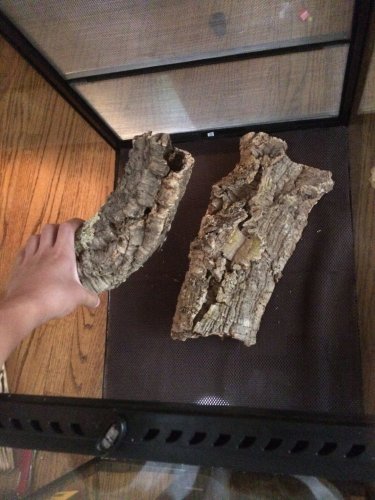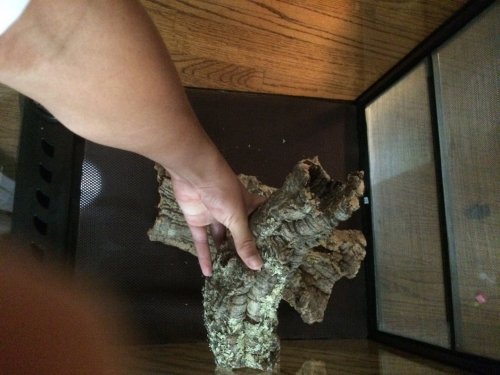Navigation
Install the app
How to install the app on iOS
Follow along with the video below to see how to install our site as a web app on your home screen.
Note: This feature may not be available in some browsers.
More options
You are using an out of date browser. It may not display this or other websites correctly.
You should upgrade or use an alternative browser.
You should upgrade or use an alternative browser.
Custom 18x18x24 Build Thread
- Thread starter CJ's Exotics
- Start date
CJ's Exotics
Chameleon Enthusiast
Great guess! That is actually what I am planning as my second idea, I really want to work with an unestablished species, like the small Calumma species. I want to work with a species like Calumma boettgeri, or one of those chameleons. I am actually looking for any LTC's, or already treated and acclimated WC's of those species, assuming that CB's are not available, so I guess you got it right, in a sense.Furcifer lateralisFTW!....Did I guess?

timw1
Chameleon Enthusiast
CJ's Exotics
Chameleon Enthusiast
I cut the hygrolon to size, now just waiting on my packages.
CJ's Exotics
Chameleon Enthusiast
I'm going to be using it for the background. I'm going to have it glued on the background with cork bark, and I plant to have Marcgravia and Wandering Jew growing on it.Are you using the hygrolon as part of a false bottom?
CJ's Exotics
Chameleon Enthusiast
With this type of enclosure, it makes drainage so much easier. Plus, I like the aesthetics. Don't worry, I have a gameplan.But why a pond? That's just a pain to deal with and serves no beneifiet to any cham.
Syreptyon
Chameleon Enthusiast
Yeah @CJ's Exotics, if you could get a breeding program for C. boettgeri going, that'd be much appreciated from the rest of us 
My local specialty shop had a WC pair of them for a little while and the bulbous blue nose is just so endearing. I wish more of the tiny species were established! I don't have room for any more big ones!
My local specialty shop had a WC pair of them for a little while and the bulbous blue nose is just so endearing. I wish more of the tiny species were established! I don't have room for any more big ones!
CJ's Exotics
Chameleon Enthusiast
The only way I could do boettgeri at this point, is if I can find some LTC's, or CB's. If you find any, please let me know!Yeah @CJ's Exotics, if you could get a breeding program for C. boettgeri going, that'd be much appreciated from the rest of us
My local specialty shop had a WC pair of them for a little while and the bulbous blue nose is just so endearing. I wish more of the tiny species were established! I don't have room for any more big ones!
CJ's Exotics
Chameleon Enthusiast
Now that I think of it, I think I worded it wrong, as if I was making a pond in the middle of the enclosure. Picture a dart frog paludarium, but on a smaller scale, and the water going to the bottom of the enclosure in the front right corner of the vivarium.But why a pond? That's just a pain to deal with and serves no beneifiet to any cham.
CJ's Exotics
Chameleon Enthusiast
CJ's Exotics
Chameleon Enthusiast
Are begonia's safe for chameleons?
Are begonia's safe for chameleons?
Listed toxins...
Calcium Oxalate Crystals, Cucurbitacin B
This doesn't sound good...
"These plants contain special cells called idioblasts. Found in a number of plant species both poisonous and non-poisonous, idioblasts differ from neighboring cells in that they contain non-living substances like oil, latex, gum, resin, tannin, pigments or minerals. One of these substances is raphides or bundles of needlelike crystals of calcium oxalate that tend to be blunt at one end and sharp at the other. The crystals are packed in a gelatinous substance that contains free oxalic acid.
When animals chew on the plant the tip of the idioblast is broken allowing saliva from the animal or sap from the plant to enter the cell. This in turn causes the gelatinous material to swell forcing the raphides (needle like calcium oxalate crystals) to violently shoot out from the cells into the surrounding area. The calcium oxalate crystals then penetrate and embed themselves into the tissues of the mouth, tongue, throat and stomach causing (in most cases) immediate discomfort and aggravation as would be expected when millions of microscopic needles are lodged in ones throat and mouth. The idioblasts may continue to expel raphides for a considerable amount of time after ingestion allowing the crystals to also embed themselves into lining of the stomach and intestine causing additional gastrointestinal upset."
"The second toxic compound “cucurbitacin B” is a biochemical compound produced by the plant in order to defend itself from being eaten. Cucurbitacins are generally cytotoxic (promote cell death) and can be extremely poisonous to some animal species. Additionally, cucurbitacins are also known for providing plants with an extremely bitter and displeasing taste."
Source: http://www.pawsdogdaycare.com/toxic-and-non-toxic-plants
Not a reptile source, but a good explanation. Not sure how "toxic" they truly are though because many common plants used in the hobby contain Oxalates.
cyberlocc
Chameleon Enthusiast
Listed toxins...
Calcium Oxalate Crystals, Cucurbitacin B
This doesn't sound good...
"These plants contain special cells called idioblasts. Found in a number of plant species both poisonous and non-poisonous, idioblasts differ from neighboring cells in that they contain non-living substances like oil, latex, gum, resin, tannin, pigments or minerals. One of these substances is raphides or bundles of needlelike crystals of calcium oxalate that tend to be blunt at one end and sharp at the other. The crystals are packed in a gelatinous substance that contains free oxalic acid.
When animals chew on the plant the tip of the idioblast is broken allowing saliva from the animal or sap from the plant to enter the cell. This in turn causes the gelatinous material to swell forcing the raphides (needle like calcium oxalate crystals) to violently shoot out from the cells into the surrounding area. The calcium oxalate crystals then penetrate and embed themselves into the tissues of the mouth, tongue, throat and stomach causing (in most cases) immediate discomfort and aggravation as would be expected when millions of microscopic needles are lodged in ones throat and mouth. The idioblasts may continue to expel raphides for a considerable amount of time after ingestion allowing the crystals to also embed themselves into lining of the stomach and intestine causing additional gastrointestinal upset."
"The second toxic compound “cucurbitacin B” is a biochemical compound produced by the plant in order to defend itself from being eaten. Cucurbitacins are generally cytotoxic (promote cell death) and can be extremely poisonous to some animal species. Additionally, cucurbitacins are also known for providing plants with an extremely bitter and displeasing taste."
Source: http://www.pawsdogdaycare.com/toxic-and-non-toxic-plants
Not a reptile source, but a good explanation. Not sure how "toxic" they truly are though because many common plants used in the hobby contain Oxalates.
Ya, I am with you, I think toxic is wrong word, Pothos has similar things and everyone uses it.
I think unpleasant if eaten would be a better way to say it. They are not going to die, they might not eat it again haha.
CJ's Exotics
Chameleon Enthusiast
Thank you for you guys input! I guess I will keep the begonia's in the dart frog enclosures just to be safe, and use the orchids for color! Are Ficus pumila safe? I have a lot of pumila from my dart frogs.
CJ's Exotics
Chameleon Enthusiast
A little bit of an update:
Unfortunately I do not have pictures of this process, because I could not without getting the phone covered in silicone and other materials. But here is what I did so far, and hopefully can provide pictures tomorrow.
First, I put a very thin layer of silicone on the back, using a putty knife to smooth it out. This is to help the gorilla glue have something to stick to.
After curing, I put gorilla glue in a very thin layer, because it does expand. I waited for it to start curing, but the first time I waited too long, and it cured. You have to time it right! Not too long, or else the hygrolon won't stick, and not too short, or the gorilla glue will seep through the hygrolon!
Next, I carefully put the hygrolon on to the gorilla glue approximately 30 minutes after application, may have been a bit less. I let it cure with the hygrolon in place.
Later, I prepared my cork for siliconing on the the background, by trying to make it as flat as possible, by sanding the back, and cutting it. I then put silicone on the back of the cork bark, and put a weight on top of it to make sure it sticks well.
Tomorrow, I will silicone the cork tube on the side of the enclosure.
Unfortunately I do not have pictures of this process, because I could not without getting the phone covered in silicone and other materials. But here is what I did so far, and hopefully can provide pictures tomorrow.
First, I put a very thin layer of silicone on the back, using a putty knife to smooth it out. This is to help the gorilla glue have something to stick to.
After curing, I put gorilla glue in a very thin layer, because it does expand. I waited for it to start curing, but the first time I waited too long, and it cured. You have to time it right! Not too long, or else the hygrolon won't stick, and not too short, or the gorilla glue will seep through the hygrolon!
Next, I carefully put the hygrolon on to the gorilla glue approximately 30 minutes after application, may have been a bit less. I let it cure with the hygrolon in place.
Later, I prepared my cork for siliconing on the the background, by trying to make it as flat as possible, by sanding the back, and cutting it. I then put silicone on the back of the cork bark, and put a weight on top of it to make sure it sticks well.
Tomorrow, I will silicone the cork tube on the side of the enclosure.
Similar threads
- Replies
- 2
- Views
- 2K
- Replies
- 2
- Views
- 2K






